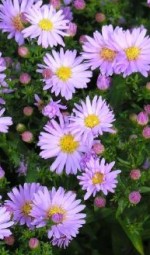 New York aster, also called Michaelmas daisy, is a herbaceous perennial native to the Atlantic Coastal Plain from Maine to Georgia where it grows in low areas, moist meadows, thickets, bluffs, shores and roadsides. It is a member of the Asteracae family that also includes daisies, sunflowers, and lettuce. Plants have hairless stems that carry slightly clasping, gray-green leaves that are smooth, lanceolate, two to five inches long, and have toothed margins. The flowerheads appear in late summer into fall and are 1 to 1.5 inches across with fifteen to twenty five deep purple ray flowers surrounding a center of yellow disc flowers. The flowers are good in the vase but not as desirable as New England asters.
New York aster, also called Michaelmas daisy, is a herbaceous perennial native to the Atlantic Coastal Plain from Maine to Georgia where it grows in low areas, moist meadows, thickets, bluffs, shores and roadsides. It is a member of the Asteracae family that also includes daisies, sunflowers, and lettuce. Plants have hairless stems that carry slightly clasping, gray-green leaves that are smooth, lanceolate, two to five inches long, and have toothed margins. The flowerheads appear in late summer into fall and are 1 to 1.5 inches across with fifteen to twenty five deep purple ray flowers surrounding a center of yellow disc flowers. The flowers are good in the vase but not as desirable as New England asters.
There are over 1,000 cultivars many of which are outstanding garden plants. They vary primarily in height and flower color, size, and fullness, so provide a good selection for many situations in wildflower gardens as well as perennial borders and seaside gardens. The generic name Aster comes from the Latin word aster meaning star and refers to the shape of the flower. The generic name Symphyotrichum comes from the Greek symph meaning coming together and trich meaning hair and possible refers to the anthers. The specific epithet novi-belgi comes from the Latin words novus meaning new and belgium meaning Belgium. New Belgium was the name of the area between Virginia and New England in the 17th century and is one of the areas in which the plant is found.
Type: Herbaceous perennial
Bloom: Flowerheads 1-1.5 inches across with fifteen to twenty five deep purple ray flowers surrounding a center of yellow disc flowers in late summer to fall
Size: 1-6’ H x 3” W
Light: Full sun
Soil: Fertile, moist, well-drained
Hardiness: Zones 4-8
Care: Pinch back before mid-summer to increase bushiness (and restrain growth if necessary); divide every 1-2 years; spray for mildew when necessary.
Pests and Diseases: Powdery mildew
Propagation: Division
Companion Plants: Ornamental grasses especially Calamagrostis ‘Karl Foerster’, switch grass, and maiden hair grass, Jerusalem sage, Sedum ‘Autumn Joy’, goldenrod ‘Firework’, Russian sage, Rudbeckia ‘Goldsturm’,
Outstanding Selections:
‘Prof. Kippenburg’ (9-12” H, lavender-blue semi double flowers)
‘Jenny’ (12-15” H, compact, cerise flowers)
‘Ada Ballard’ (3’ H, lavender-blue double flowers)
‘Patricia Ballard’ 3’ H, semi-double pink flowers)
‘Eventide’ (3-4’ H, 2” semi-double, violet-blue flowers)
‘Boningdale White’ (3.5-4’ H, clean white, semi-double to double)